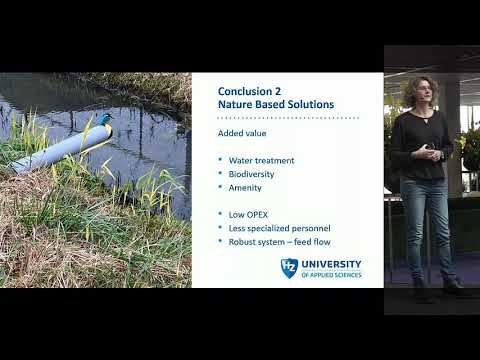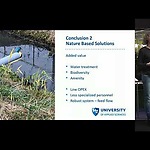One of the alternative local water sources combines i) rainwater collected from the Dow site and its periphery, ii) treated Dow wastewater and iii) treated municipal wastewater from the Terneuzen Waste Water Treatment Plant (WWTP). This water mixture is treated to the required industrial quality in a desalination plant (Ultrafiltration à Ion eXchange à Reverse Osmosis). To increase the efficiency of the desalination and reduce costs, a nature-based pre-treatment (wetland) is investigated with the objective to reduce biological fouling of the membranes with minimal use of energy and chemicals. To the authors’ best knowledge, this is the first study in which outdoor aerated wetlands are applied on such a large scale as pretreatment before a desalination plant.
The pilot setup of wetlands was placed on the Dow/Evides site and is operational since April 2019. It consists of two aerated horizontal subsurface flow wetland cells, based on the Forced Bed AerationTM principle, 350 m² (28 m x 12.5 m x 1 m) each and fed with 10 m³/h municipal effluent from the Terneuzen WWTP and effluent from the Dow WWTP. Both pilot cells are filled with clay aggregates and are aerated in three separate zones by means of blowers, which are connected to aeration grids at the bottom of the wetland cells. The wetland is covered with common reed – Phragmites australis – and the hydraulic residence time in each wetland cell is 12 hours.
After 18 months of research and a variety of settings, it can be concluded that aerated constructed wetlands can supply more biologically stable effluent to the desalination plant. Ammonium was completely removed in the wetlands. The incoming water mixture of the wetland consists of substances that are not easily biodegradable. However, the average low concentrations of COD and TN (25 mg/L and 10 mg/L respectively) are reduced about 25% in the wetland. There was a trade-off found between COD and TN removal, as an increase in the oxygen availability in the filter results in more COD removal and less TN removal. Seasonal variation only affects the removal of TN, where the removal efficiency for municipal wastewater was 38% during summer while being 24% during winter.
These positive results pave the way towards full-scale implementation in the near future.
Source: Martens, M. 2021. Aerated wetlands as innovative pretreatment for desalination plant for chemical industry. Wetlands for wastewater treatment and Nature-Based solutions, Risk & Resilience. AIWW 2021.
In-person Conference
Source: YouTube - Aerated wetlands

